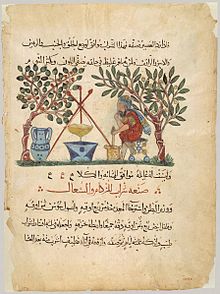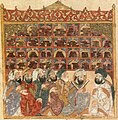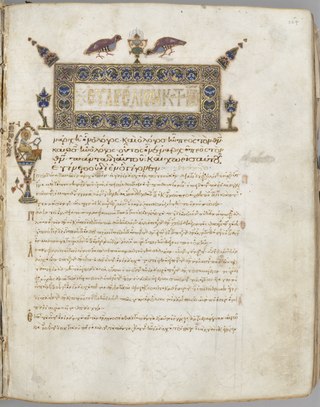
An illuminated manuscript is a formally prepared document where the text is decorated with flourishes such as borders and miniature illustrations. Often used in the Roman Catholic Church for prayers and liturgical books such as psalters and courtly literature, the practice continued into secular texts from the 13th century onward and typically include proclamations, enrolled bills, laws, charters, inventories, and deeds.

Pedanius Dioscorides, "the father of pharmacognosy", was a Greek physician, pharmacologist, botanist, and author of De materia medica, a 5-volume Greek encyclopedia about herbal medicine and related medicinal substances, that was widely read for more than 1,500 years. For almost two millennia Dioscorides was regarded as the most prominent writer on plants and plant drugs.

The maqāma is an (originally) Arabic prosimetric literary genre of picaresque short stories originating in the tenth century C.E.. The maqāmāt are anecdotes told by a fictitious narrator which typically follow the escapades of a roguish protagonist as the two repeatedly encounter each other in their travels. The genre is known for its literary and rhetorical complexity, as well as its alternating use of rhymed verse with a form of Arabic rhymed prose known as saj’. The two most well-known authors within the genre are Badī' al-Zaman al-Hamadhāni, one of its earliest exponents, and al-Harīrī of Basra, whose maqāmāt are commonly held responsible for the genre's rise in popularity from the eleventh century onward. Interest in al-Hariri's Maqāmāt spread throughout much of the Islamic Empire, with translations and original works appearing in Hebrew, Syriac and Persian. Many authors still contribute to and draw inspiration from the literary genre of Maqāma to this day.
Badi' al-Zamān al-Hamadānī or al-Hamadhānī was a medieval Arab poet and man of letters. He is best known for his work the Maqamat Badi' az-Zaman al-Hamadhani, a collection of 52 episodic stories of a rogue, Abu al-Fath al-Iskandari, as recounted by a narrator, 'Isa b. Hisham. His Arabic name translates into "The Wonder of the Age".

The Artuqid dynasty was established in 1102 as an Anatolian Beylik (Principality) of the Seljuk Empire. It formed a Turkoman dynasty rooted in the Oghuz Döğer tribe, and followed the Sunni Muslim faith. It ruled in eastern Anatolia, Northern Syria and Northern Iraq in the eleventh through thirteenth centuries. The Artuqid dynasty took its name from its founder, Artuk Bey, who was of the Döger branch of the Oghuz Turks and ruled one of the Turkmen beyliks of the Seljuk Empire. Artuk's sons and descendants ruled the three branches in the region: Sökmen's descendants ruled the region around Hasankeyf between 1102 and 1231; Ilghazi's branch ruled from Mardin and Mayyafariqin between 1106 and 1186 and Aleppo from 1117–1128; and the Harput line starting in 1112 under the Sökmen branch, and was independent between 1185 and 1233.

Yahya ibn Mahmud al-Wasiti was a 13th-century Iraqi-Arab painter and calligrapher, noted for being the scribe and illustrator of al-Hariri's Maqamat dated 1237 CE.

The Naples Dioscurides, in the Biblioteca Nazionale, Naples, is an early 7th-century secular illuminated manuscript Greek herbal. The book has 172 folios and a page size of 29.7 x 14 cm and the text is a redaction of De Materia Medica by the 1st century Greek military physician Dioscorides, with descriptions of plants and their medicinal uses. Unlike De Materia Medica, the text is arranged alphabetically by plant.

Diyāʾ al-Dīn Abū Muḥammad ʿAbd Allāh ibn Aḥmad al-Mālaqī, commonly known as Ibn al-Bayṭār was an Andalusian Arab physician, botanist, pharmacist and scientist. His main contribution was to systematically record the additions made by Islamic physicians in the Middle Ages, which added between 300 and 400 types of medicine to the one thousand previously known since antiquity. He was a student of Abu al-Abbas al-Nabati.
The Seljuk Empire, or the GreatSeljuk Empire, was a high medieval, culturally Turco-Persian, Sunni Muslim empire, established and ruled by the Qïnïq branch of Oghuz Turks. It spanned a total area of 3.9 million square kilometres from Anatolia and the Levant in the west to the Hindu Kush in the east, and from Central Asia in the north to the Persian Gulf in the south.

Al-Hariri of Basra was a poet belonging to the Beni Harram tribe of Bedouin Arabs, who lived and died in the city of Basra, modern Iraq. He was a scholar of the Arabic language and a dignitary of the Seljuk Empire, which ruled Iraq during his lifetime, from 1055 to 1135.
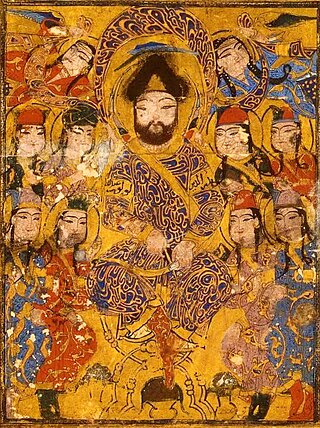
Badr al-Din Lu'lu' was successor to the Zengid emirs of Mosul, where he governed in variety of capacities from 1234 to 1259 following the death of Nasir ad-Din Mahmud. He was the founder of the short-lived Luluid dynasty. Originally a slave of the Zengid ruler Nur al-Din Arslan Shah I, he was the first Middle-Eastern mamluk to transcend servitude and become an emir in his own right, founding the dynasty of the Lu'lu'id emirs (1234-1262), and anticipating the rise of the Bahri Mamluks of the Mamluk Sultanate of Egypt by twenty years. He preserved control of al-Jazira through a series of tactical submissions to larger neighboring powers, at various times recognizing Ayyubid, Rûmi Seljuq, and Mongol overlords. His surrender to the Mongols after 1243 temporarily spared Mosul the destruction experienced by other settlements in Mesopotamia.

The Physician Preparing an Elixir is a miniature on a folio from an illustrated manuscript copy, now in the Metropolitan Museum of Art in New York of De Materia Medica, a large herbal or work on the (mostly) medical uses of plants originally written by the ancient Greco-Roman physician, Pedanius Dioscorides, in the first century AD. This page of the manuscript, dated 1224 AD, is made from paper, sized 24.8 cm wide and 33.2 cm long, and is decorated by opaque watercolor, ink, and gold detailing. It is visually split into three horizontal portions from the top of the page to the bottom; the top of the page is dominated by two lines of Arabic script, followed by the image and then five more lines of text in Arabic. The writing below the image is predominantly black with the exception of one line, which is written in red ink and is therefore highlighted to the viewer. The page is usually not on display.

De materia medica is a pharmacopoeia of medicinal plants and the medicines that can be obtained from them. The five-volume work was written between 50 and 70 CE by Pedanius Dioscorides, a Greek physician in the Roman army. It was widely read for more than 1,500 years until supplanted by revised herbals in the Renaissance, making it one of the longest-lasting of all natural history and pharmacology books.

Iraqi art is one of the richest art heritages in world and refers to all works of visual art originating from the geographical region of what is present day Iraq since ancient Mesopotamian periods. For centuries, the capital, Baghdad was the Medieval centre of the literary and artistic Arab world during the Abbasid Caliphate, in which Baghdad was the capital, but its artistic traditions suffered at the hands of the Mongol invaders in the 13th century. During other periods it has flourished, such as during the reign of Pir Budaq, or under Ottoman rule in the 16th century when Baghdad was known for its Ottoman miniature painting. In the 20th century, an art revival, which combined both tradition and modern techniques, produced many notable poets, painters and sculptors who contributed to the inventory of public artworks, especially in Baghdad. These artists are highly regarded in the Middle East, and some have earned international recognition. The Iraqi modern art movement had a profound influence on pan-Arab art generally.

Arabic miniatures are small paintings on paper, usually book or manuscript illustrations but also sometimes separate artworks that occupy entire pages. The earliest example dates from around 690 AD, with a flourishing of the art from between 1000 and 1200 AD in the Abbasid caliphate. The art form went through several stages of evolution while witnessing the fall and rise of several Islamic caliphates. Arab miniaturists absorbed Chinese and Persian influences brought by the Mongol destructions, and at last, got totally assimilated and subsequently disappeared due to the Ottoman occupation of the Arab world. Nearly all forms of Islamic miniatures owe their existences to Arabic miniatures, as Arab patrons were the first to demand the production of illuminated manuscripts in the Caliphate, it wasn't until the 14th century that the artistic skill reached the non-Arab regions of the Caliphate.
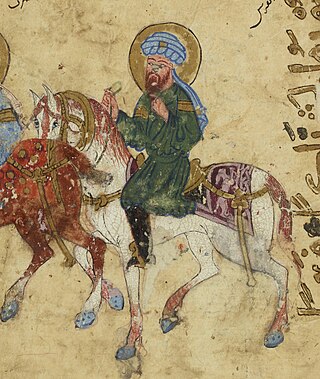
The Maqāmāt al-Ḥarīrī is a collection of fifty tales or maqāmāt written at the end of the 11th or the beginning of the 12th century by al-Ḥarīrī of Basra (1054–1122), a poet and government official of the Seljuk Empire. The text presents a series of tales regarding the adventures of the fictional character Abū Zayd of Saruj who travels and deceives those around him with his skill in the Arabic language to earn rewards. Although probably less creative than the work of its precursor, Maqāmāt al-Hamadhānī, the Maqāmāt al-Ḥarīrī became extremely popular, with reports of seven hundred copies authorized by al-Ḥarīrī during his lifetime.

The Sharbush or Harbush probably derived from Persian word Serpush was a special Turkic military furred hat, worn in Central Asia and the Middle East in the Middle Ages. It appears prominently in the miniatures depicting Badr al-Din Lu'lu'. It was a stiff cap of the military class, with a triangular front which was sometimes addorned with a metal plaque. It was sometimes supplemented with a small kerchief which formed a small turban, named takhfifa. The wearing of the Sharbūsh was one of the key graphical and sartorial elements to differentiate Turkic figures from Arab ones in medieval Middle-Eastern miniatures.

The Kitāb al-bayṭara is a 12th-century Arabic treatise on horse medicine by Aḥmad ibn al-Ḥusayn ibn al-Aḥnaf.

British Library, Add. 7170 is a Syriac manuscript dated to circa 1220 CE. This is one of the few highly illustrated Middle-Eastern Christian manuscripts from the 13th century. The colophon is lost, but a scribal note indicates that the manuscript was created at the time of Patriarch John and Maphrian Ignatius, who may be identified as John XII of Antioch (1208-1220) and Ignatius III David, respectively, which gives a completion date circa 1215–1220. The location where the manuscript was created is uncertain, but is generally thought to be the Jazira region near Mosul, possibly at the monastery of Deir Mar Mattai, due to artistic similarities with another manuscript securely attributed to Mosul.

Vatican Library, Syr. 7170 is a Syriac manuscript dated to circa 1220 CE. This is one of the few highly illustrated Middle-Eastern Christian manuscripts from the 13th century.

